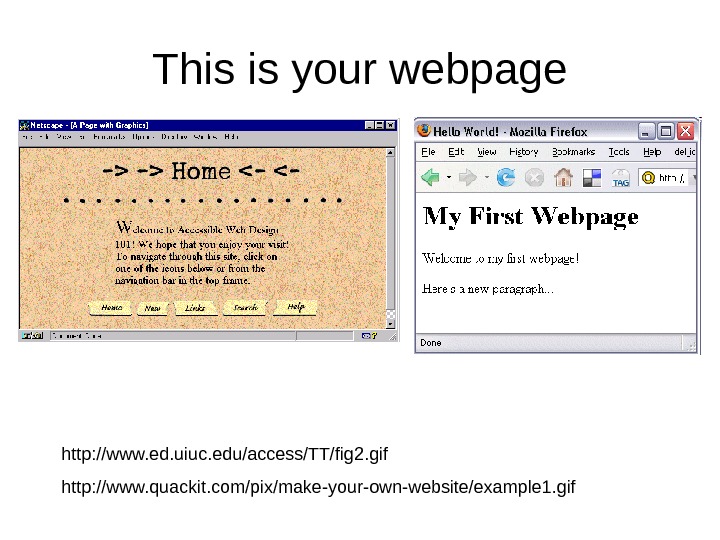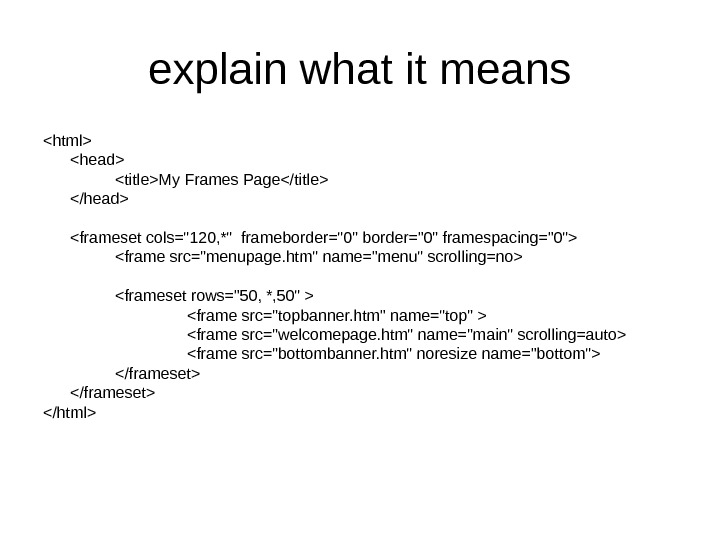Week 4 — Lab Frames This is






















- Размер: 243.5 Кб
- Количество слайдов: 21
Описание презентации Week 4 — Lab Frames This is по слайдам
 Week 4 — Lab Frames
Week 4 — Lab Frames
 This is your webpage http: //www. ed. uiuc. edu/access/TT/fig 2. gif http: //www. quackit. com/pix/make-your-own-website/example 1. gif
This is your webpage http: //www. ed. uiuc. edu/access/TT/fig 2. gif http: //www. quackit. com/pix/make-your-own-website/example 1. gif
 This is your webpage on frames http: //www. ibm. com/developerworks/library/wa-fram/frames 3. gif http: //www. brighthub. com/computing/windows-platform/articles/7055. aspx
This is your webpage on frames http: //www. ibm. com/developerworks/library/wa-fram/frames 3. gif http: //www. brighthub. com/computing/windows-platform/articles/7055. aspx
 • What is a frame ? – Holds a file – divide the screen into windows • Windows can have XHTML documents • What is a frameset ? – holds one or more frames – Specifies: • # of columns and rows • percentage/pixels of space each occupies – A file that tell the browser how the screen is to be divided into frames
• What is a frame ? – Holds a file – divide the screen into windows • Windows can have XHTML documents • What is a frameset ? – holds one or more frames – Specifies: • # of columns and rows • percentage/pixels of space each occupies – A file that tell the browser how the screen is to be divided into frames
 • This means that to make a webpage with frames you need 2 things: – A XHTML with frames – Separate XHTML files that you will load into these frames • To see the webpage you load the XHTML with frames – It loads the individual pages automatically.
• This means that to make a webpage with frames you need 2 things: – A XHTML with frames – Separate XHTML files that you will load into these frames • To see the webpage you load the XHTML with frames – It loads the individual pages automatically.
 Frames Pros and Cons • Pros – Easier to navigate site • one frame has main navigation bar – can save designer’s time when making changes and updates to site. • Changes only made on the one web page that is attached to the frame – not every page on site. – viewer can navigate faster • not every frame has to be reloaded each time a new page is visited. • especially true if one frame has graphics – Especially if source file is big • Loading initial page may be slow to load – but rest of pages will be faster
Frames Pros and Cons • Pros – Easier to navigate site • one frame has main navigation bar – can save designer’s time when making changes and updates to site. • Changes only made on the one web page that is attached to the frame – not every page on site. – viewer can navigate faster • not every frame has to be reloaded each time a new page is visited. • especially true if one frame has graphics – Especially if source file is big • Loading initial page may be slow to load – but rest of pages will be faster
 • Cons – some browsers don’t support frames. • Minor problem – some people don’t like them. • same thing for other web design components (e. g. , Flash) • a lot of this is because some web pages used frames badly – avoidable
• Cons – some browsers don’t support frames. • Minor problem – some people don’t like them. • same thing for other web design components (e. g. , Flash) • a lot of this is because some web pages used frames badly – avoidable
 set to: • «HTML Frameset DTD» – • or «XHTML Frameset DTD». – defines a window in the Can have attributes, e. g. : border scrolling Noresize Frameborder Marginheight Marginwidth src
set to: • «HTML Frameset DTD» – • or «XHTML Frameset DTD». – defines a window in the Can have attributes, e. g. : border scrolling Noresize Frameborder Marginheight Marginwidth src
 What does this page look like? Answer: 3 Vertical Frames (I: \COMP 1229\2012 W\Week 4 Lab-Frames\Eg 2 -3 Vert. Frames) These windows need names to load pages. e. g. * is needed because you don’t know what screen resolution user has. – It automatically adjusts page to size of screen Notice anything different? • Where’s the ? • replaces it
What does this page look like? Answer: 3 Vertical Frames (I: \COMP 1229\2012 W\Week 4 Lab-Frames\Eg 2 -3 Vert. Frames) These windows need names to load pages. e. g. * is needed because you don’t know what screen resolution user has. – It automatically adjusts page to size of screen Notice anything different? • Where’s the ? • replaces it
 • src setting – add default pages to windows • default pages – pages loaded when the frameset is opened first time • name setting – adds names to each window – Lets us open a page in a window.
• src setting – add default pages to windows • default pages – pages loaded when the frameset is opened first time • name setting – adds names to each window – Lets us open a page in a window.
 In Class Assignment • Make a webpage with frames – 3 frames • 2 columns – Left column 120 pixels in width – Right Column rest of screen • 2 rows in second column – Bottom row 50 pixels – Top row rest of screen • Make the left column the index frame • Rest of the columns can contain any content you like • Make sure that each window loads different content.
In Class Assignment • Make a webpage with frames – 3 frames • 2 columns – Left column 120 pixels in width – Right Column rest of screen • 2 rows in second column – Bottom row 50 pixels – Top row rest of screen • Make the left column the index frame • Rest of the columns can contain any content you like • Make sure that each window loads different content.
 Solution
Solution
 Logic of code: • – One column, 120 pixels wide – 2 nd column rest of screen • This column contains 2 rows – Bottom is 50 pixels – Top is remainder. – windows need names to load pages.
Logic of code: • – One column, 120 pixels wide – 2 nd column rest of screen • This column contains 2 rows – Bottom is 50 pixels – Top is remainder. – windows need names to load pages.
 If you want to open a file in a frame (e. g. the one named main) use a hyperlink: Opens new. File in the main window Some target names are reserved: • _blank loads the page into a new browser window • _self loads the page into the current window. • _parent loads the page into the frame that is superior to the frame the hyperlink is in. • _ top cancels all frames, loads in full browser window.
If you want to open a file in a frame (e. g. the one named main) use a hyperlink: Opens new. File in the main window Some target names are reserved: • _blank loads the page into a new browser window • _self loads the page into the current window. • _parent loads the page into the frame that is superior to the frame the hyperlink is in. • _ top cancels all frames, loads in full browser window.
 explain what it means
explain what it means
 frameborder=»0″ framespacing=»0“ • Makes frame borders invisible. Applies to the frameset only. – Challenge: make only the right portion of the webpage’s boarders invisible • Sol’n: put the frameborder=»0″ framespacing=»0“ only in the second frameset tag. • Notice: frameborder=»0″ framespacing=»0“ also prevents user from resizing Noresize – prevents user from changing size of the window • Notice: all the borders touching frame become frozen. • So you might noresize neighbours unintentionally if they only have 1 border & it is with you. Scrolling – allows you to hide / auto show the scroll bar
frameborder=»0″ framespacing=»0“ • Makes frame borders invisible. Applies to the frameset only. – Challenge: make only the right portion of the webpage’s boarders invisible • Sol’n: put the frameborder=»0″ framespacing=»0“ only in the second frameset tag. • Notice: frameborder=»0″ framespacing=»0“ also prevents user from resizing Noresize – prevents user from changing size of the window • Notice: all the borders touching frame become frozen. • So you might noresize neighbours unintentionally if they only have 1 border & it is with you. Scrolling – allows you to hide / auto show the scroll bar
 • Frameset not supported in HTML 5 • NOFrames element – gives alternate content to browsers that: • do not support frames • or have frames disabled – optional • Should always include it.
• Frameset not supported in HTML 5 • NOFrames element – gives alternate content to browsers that: • do not support frames • or have frames disabled – optional • Should always include it.
 • ROWS and COLS attributes – define dimensions of each frame in the set. – Takes comma-separated list of lengths • specified in: – Pixels » used when the frame consists of objects with a fixed size in pixels — e. g. , picture – Percentage – relative length » expressed as i * where i is an integer. » example, ROWS=»3*, *» ( * is equivalent to 1* ) will have its first row allotted three times the height of the second row. – ROWS attribute give the height of each row, from top to bottom. – COLS attribute gives the width of each column from left to right. – If ROWS or COLS is omitted, implied value for attribute is 100%. – If both attributes are specified, a grid is defined and filled left-to-right then top-to-bottom.
• ROWS and COLS attributes – define dimensions of each frame in the set. – Takes comma-separated list of lengths • specified in: – Pixels » used when the frame consists of objects with a fixed size in pixels — e. g. , picture – Percentage – relative length » expressed as i * where i is an integer. » example, ROWS=»3*, *» ( * is equivalent to 1* ) will have its first row allotted three times the height of the second row. – ROWS attribute give the height of each row, from top to bottom. – COLS attribute gives the width of each column from left to right. – If ROWS or COLS is omitted, implied value for attribute is 100%. – If both attributes are specified, a grid is defined and filled left-to-right then top-to-bottom.
 Example: grid with two rows and three columns Table of Contents
Example: grid with two rows and three columns Table of Contents
 Example: nested FRAMESET elements to define two frames in the first row and one frame in the second row Table of Contents
Example: nested FRAMESET elements to define two frames in the first row and one frame in the second row Table of Contents
 • ONLOAD and ONUNLOAD attributes – specify client-side scripting actions to perform • when the frames have all been loaded or removed. – ONLOAD= Script (all frames have been loaded) – ONUNLOAD= Script (all frames have been removed)
• ONLOAD and ONUNLOAD attributes – specify client-side scripting actions to perform • when the frames have all been loaded or removed. – ONLOAD= Script (all frames have been loaded) – ONUNLOAD= Script (all frames have been removed)

